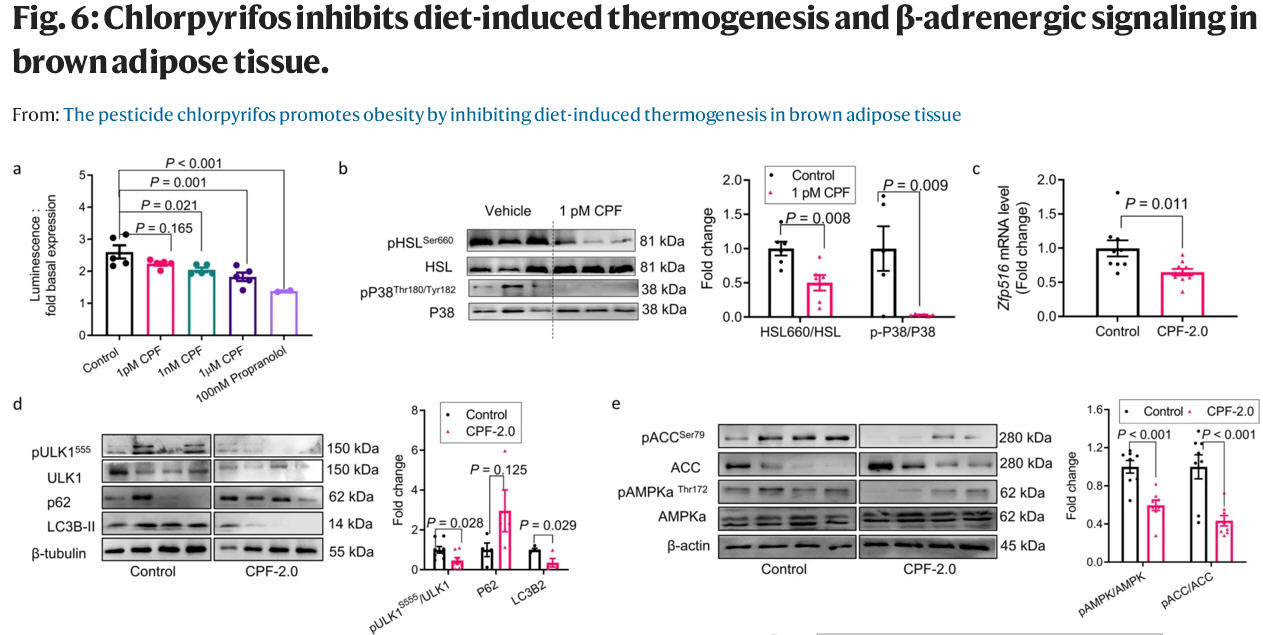博文
常见农药可能导致全球肥胖危机
||
常见农药可能导致全球肥胖危机
诸平



据加拿大麦克马斯特大学(McMaster University)2021年8月27日提供的消息,一项由麦克马斯特大学科学家领导,有中美科学家参与的研究表明,一种常用的杀虫剂可能是全球肥胖流行的部分原因(Common pesticide may contribute to global obesity crisis)。
毒死蜱(chlorpyrifos)在加拿大被禁止用于食物,但在世界其他许多地方被广泛喷洒在水果和蔬菜上。研究人员发现,毒死蜱会减缓老鼠棕色脂肪组织(brown adipose tissue)中的卡路里燃烧。减少卡路里的燃烧,这一过程被称为饮食诱导生热(diet-induced thermogenesis),会导致身体储存这些额外的卡路里,促进肥胖。
科学家们在研究了棕色脂肪细胞(brown fat cells)中34种常用的杀虫剂和除草剂,并测试了毒死蜱对喂食高热量食物的老鼠的影响后,得出了这一发现。他们的研究结果于2021年8月27日已经在《自然通讯》(Nature Communications)杂志网站发表——Bo Wang, Evangelia E. Tsakiridis, Shuman Zhang, Andrea Llanos, Eric M. Desjardins, Julian M. Yabut, Alexander E. Green, Emily A. Day, Brennan K. Smith, James S. V. Lally, Jianhan Wu, Amogelang R. Raphenya, Krishna A. Srinivasan, Andrew G. McArthur, Shingo Kajimura, Jagdish Suresh Patel, Michael G. Wade, Katherine M. Morrison, Alison C. Holloway, Gregory R. Steinberg .The pesticide chlorpyrifos promotes obesity by inhibiting diet-induced thermogenesis in brown adipose tissue. Nature Communications, Published: 27 August 2021. Volume 12, Article number: 5163. DOI: 10.1038/s41467-021-25384-y. https://doi.org/10.1038/s41467-021-25384-y,该研究结果可能对公众健康(public health)具有重要意义。
参与该研究的科学家除了有来自加拿大麦克马斯特大学(McMaster University)的之外,还有来自中国农业大学(China Agricultural University)、美国波士顿贝斯以色列女执事医疗中心和哈佛医学院(Beth Israel Deaconess Medical Center and Harvard Medical School, Boston, MA, USA)、美国爱达荷大学(University of Idaho, Moscow, ID, USA)以及加拿大卫生部环境卫生科学与研究局(Environmental Health Science & Research Bureau, Health Canada)的研究人员。
麦克马斯特大学新陈代谢、肥胖和糖尿病研究中心(Centre for Metabolism, Obesity, and Diabetes Research at McMaster)联席主任、医学教授、此项研究的通讯作者格雷戈里·斯坦伯格(Gregory Steinberg)说:“棕色脂肪是我们体内的代谢炉,燃烧卡路里,不像用来储存卡路里的正常脂肪。这会产生热量,防止卡路里作为正常的白色脂肪沉积在我们的身体上。我们知道棕色脂肪在寒冷和进食时被激活。围绕饮食和运动的生活方式的改变很少能导致持续的减肥(sustained weight loss)。我们认为部分问题可能是毒死蜱对代谢炉的内在调节。”
格雷戈里·斯坦伯格说,毒死蜱只需要每天抑制棕色脂肪中40卡路里的能量消耗,就会导致成年人肥胖,这将导致每年额外增加5磅(约4.5 kg)的体重。
他说,虽然包括毒死蜱在内的几种环境毒素与人类和动物的肥胖率上升有关,但大多数研究都将体重增加归因于食物摄入(food intake )量的增加,而不是卡路里的燃烧。
虽然毒死蜱在食品上的使用在加拿大是被禁止的,但进口农产品仍可能使用毒死蜱处理。
格雷戈里·斯坦伯格说:“虽然这一发现还没有在人类身上得到证实,但一个重要的考虑是,无论何时,只要可能,食用来自加拿大当地的水果和蔬菜,以及如果食用进口农产品,务必确保彻底清洗为宜。”上述介绍,仅供参考。欲了解更多信息,敬请注意浏览原文或者相关报道。
Common pesticide to be banned over links to problems in children
Obesity results from a caloric imbalance between energy intake, absorption and expenditure. In both rodents and humans, diet-induced thermogenesis contributes to energy expenditure and involves the activation of brown adipose tissue (BAT). We hypothesize that environmental toxicants commonly used as food additives or pesticides might reduce BAT thermogenesis through suppression of uncoupling protein 1 (UCP1) and this may contribute to the development of obesity. Using a step-wise screening approach, we discover that the organophosphate insecticide chlorpyrifos suppresses UCP1 and mitochondrial respiration in BAT at concentrations as low as 1 pM. In mice housed at thermoneutrality and fed a high-fat diet, chlorpyrifos impairs BAT mitochondrial function and diet-induced thermogenesis, promoting greater obesity, non-alcoholic fatty liver disease (NAFLD) and insulin resistance. This is associated with reductions in cAMP; activation of p38MAPK and AMPK; protein kinases critical for maintaining UCP1 and mitophagy, respectively in BAT. These data indicate that the commonly used pesticide chlorpyrifos, suppresses diet-induced thermogenesis and the activation of BAT, suggesting its use may contribute to the obesity epidemic.
https://blog.sciencenet.cn/blog-212210-1301835.html
上一篇:MIT: 使光绕弯就是为了更便宜的互联网
下一篇:一种只用蓝光从六元环中除去硫、氮或氧原子的反应